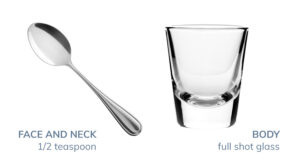Fun Facts
Did you know that moisturizer with sunscreen in it still only gives you 2 hours of sun protection?
Did you know sunscreen sticks are easy, quick ways to reapply, especially on the hands and for kids’ faces?
Did you know that when the average person applies a sunscreen with an SPF 30, they are actually getting an SPF 16? That’s due to the amount that we put on.
SPF Explained
SPF stands for Sun Protection Factor and is how we measure the protection from the sun’s UVB rays. We recommend staying over 30 SPF.
You’ll also want to make sure your sunscreen is “broad spectrum” — meaning it protects from both UVA and UVB rays. An easy way to distinguish the two is UVA(ging) and UVB(urning). Both rays have overlapping effects (i.e. both can cause premature aging), but UVA rays are mostly responsible for fine lines and dark spots, while UVB rays play the most significant role in producing skin cancers and sunburns.
The Different Types of Sunscreen
There are two main types of sunscreen: physical (aka mineral) and chemical. Both absorb the sun’s UV rays to help prevent skin damage, but physical also reflects some UV rays.
What Actually is “Reef-Safe”?🪸
Most importantly, it means not a spray. Aerosol sprays are not reef friendly. Secondly, it means no ingredients like oxybenzone, homosalate, octinoxate, nanoparticles, or octocrylene. Unfortunately, entire brands can call themselves “reef-safe” but then contain reef-unsafe ingredients, so please don’t judge by that label 😡. You cannot go by brand; you need to check the actual ingredient list.
Let’s not forget about other ways of staying sun-safe, including wearing protective clothing (such as a wide-brimmed hat 👒, sunglasses 🕶, long-sleeve shirt, and SPF clothing) and seeking shade (especially between the hours of 10 a.m. and 4 p.m.).
The best sunscreen for you is the one you’ll want to wear each and every day. Some sunscreens may blend into your skin tone better (tinted or not tinted), you may like the scent (or no scent) of some more than others, and so on. But rest assured; there is a perfect pick for you.

Everyone under the sun should wear sunscreen — no matter your skin tone. Generally speaking, you’ll need one-half a teaspoon of sunscreen, or two finger lengths long, for your face and neck and one ounce (a shot-glass-full) for your entire body. Because sunscreens naturally break down over time, we recommend reapplying every two hours and even more frequently if you’re doing something that will make sunscreen break down faster, like swimming or sweating. Plus, the best practice is to apply sunscreen 15 minutes prior to sun exposure.
